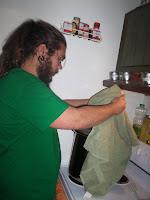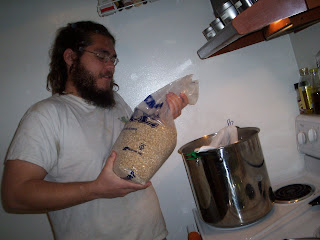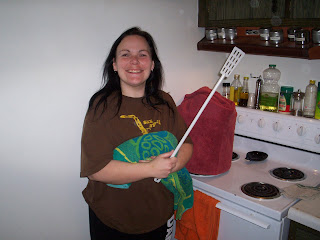I'd been itching to do a wheat beer for a while now. We like wheat; she makes whole wheat bread, we eat whole wheat pasta, cream of wheat for breakfast...you get the idea. And to top it all off, she really likes Blue Moon. Witbier time!
But not exactly. This recipe fits the BJCP style guidelines for an American Wheat Beer, but is spiced in a classic Witbier way. The brew process was fun and smelled great. But most importantly, it was our first straight "grain to glass" brew. No extracts here folks, all fermentables came straight from the grain!
I was proud, calculations were spot-on, except for efficiency, which was underestimated. Our process was 88% efficient this session. That's higher than many commercial breweries! So here we go...
Spicy American Wheat Ale: All-Grain
 4 gallon batch
4 gallon batchPredicted OG: 1.052
Actual OG: 1.054
Predicted FG: 1.012
Fermentables:
-4 lbs US 2-row Pale Malt
-4 lbs Flaked Wheat
 Hops:
Hops:
-1 oz US Golding 4.5% (60 min)
Yeast:
-Safbrew WB-06 dry ale yeast
-4 lbs US 2-row Pale Malt
-4 lbs Flaked Wheat
 Hops:
Hops:-1 oz US Golding 4.5% (60 min)
Yeast:
-Safbrew WB-06 dry ale yeast
Others:
-0.75 oz dried orange peel (homemade)
Process:
We heated 3 gallons of water (1.5 qt water/1 lb of grain) to a strike temperature of 165 degrees Fahrenheit, with our trusty strainer bag secured to the pot's handles.
This temperature was calculated so that when the 8 pounds of 65 degree Fahrenheit grain hit the 3 gallons of 165 degree water, we would achieve a mash temperature of 153 degrees. And sure enough, we hit it dead on.

 With the stove top now turned off, I stirred the mash heartily to break up any clumps. Then we put the lid on the pot, wrapped a towel around it, and left it to mash at 153 for 60 minutes. Using the simple towel method, we didn't lose a single degree Fahrenheit during the mash.
With the stove top now turned off, I stirred the mash heartily to break up any clumps. Then we put the lid on the pot, wrapped a towel around it, and left it to mash at 153 for 60 minutes. Using the simple towel method, we didn't lose a single degree Fahrenheit during the mash.And no, the other end of the mash paddle is not in my nose, though that would be a neat trick.
Next I removed the grain bag (this is where bicep strength comes in!) and set it into our now-upgraded drip tray...another bucket! Then I poured these first runnings into a food grade bucket, and poured 2.5 gallons of water into our pot.
No need to be fancy unless you're a real stickler, I just measure gallons with an old juice jug
Then, once the 2.5 gallons of water reached 180 degrees, we turned off the burner and replaced the grain bag. I stirred the grains once more with the mash paddle, then covered the pot and let it sit for 15 minutes. This BIAB (brew in a bag) batch sparge method majorly contributes to the high efficiency of this system.
After this 15 minute sparge, I removed the grain bag from the sparge water and returned it to the drip tray for its last drippings. No waste in this brewhouse! Or should I say brewpartment? Anyway, now comes the fun part...
Combine the wort and the sparge water,

Add the hops,
And boil!
Important Note: Remember to watch your pot (contrary to old wives tales it will boil), and stir to prevent boil-over. Hot break can be hellacious, and nobody wants to lose any of their beer, not to mention clean up sticky burnt wort. The more head space your pot has, the better.
After about 80 minutes of boiling we whipped out the trusty mini-food processor to crush the coriander. I decided to throw the dried orange peels in there too, as they were pretty large pieces to begin with.
If you aren't as frugal you could go buy bitter or sweet orange peel (drastically different, research first) from your brew shop for about $1.50 to $2 an ounce. But if you would like to use the same method we did, just peel your oranges with a paring knife, leaving as much pith (the bitter white part) on the fruit as possible. Break the peels into your desired size, and set them out in a dry spot on a plate for 3-4 days. You could expedite the process by putting them on a baking sheet in the oven at a low setting for an hour or two. Use organic fruits if you want to make sure you're not drinking pesticides.
Then I poured the coriander and orange peel into a little nylon bag, tied it off, and dropped it in to boil for the last five minutes. The short boil is to preserve delicate flavors and aromas that over-cooking can destroy.

Next, we started loading our sink with cold water and ice for the cooling. We can cool to a respectable 100 degrees Fahrenheit in 30 minutes if we just replace the water when it is no longer cold, about once every 5 to 10 minutes in our sink.
ALWAYS REMEMBER TO SANITIZE!
Here I'm adding 1 tsp Iodophor to 1.5 gallons of water to sanitize the bucket, lid, mash paddle (for fishing out bags) and airlock. Cooling is a prime time for this.
I removed the bags to a drip tray to save every possible drop,
Poured the cooled wort into the sanitized fermenting bucket,
Then topped off with the drippings.
We ended up just under the 4 gallon mark, so I added a little dechlorinated water to get us to the desired volume.
Took a hydrometer reading...
OG: 1.054
and pitched the yeast. Now it's sitting on the right, next to our Engagement Day American Ale, bubbling away! More updates at bottling time!
-Myles

















































